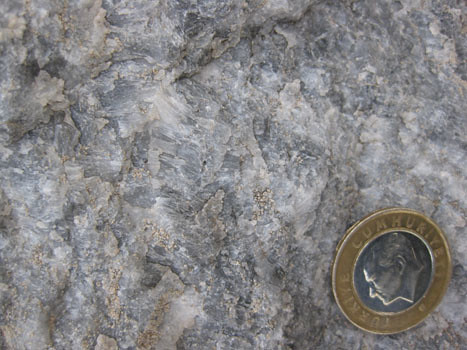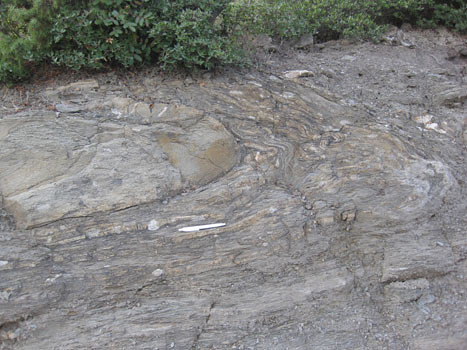Picking up where we left off last time, we were in some partly-serpentenized peridotite, part of the Burham Ophiolite in Turkey’s Tavşanlı Zone, an ancient tectonic suture.
Our next stop on the field trip allowed us to visit some diabase dikes:
Here’s a close-up of the right contact of the dike with the host peridotite:
The field notebook’s long edge is ~18 cm. And here it is again, annotated:
Near the village of Oranheli, we stopped to examine a jadeite meta-granitoid, a rock only a metamorphic petrologist could love. There were, however, a lot of metamorphic petrologists on the trip, and they were very keen on checking it out. This was the first of many occasions when random Turkish citizens would stroll up to our odd group to find out just what the hell we were doing:
Further along, we saw a meta-basite (meta-basalt) within the meta-granitoid, and there I got a refreshing whiff of structure. Here’s a random isoclinal fold of a meta-granitoid dike cross-cutting the meta-basite, with a Turkish 1-lira coin (about the same size as a U.S. quarter) for scale:
Next up were some very cool rocks: marbles with extremely elongated calcite crystals.
These needle-like crystals are interpreted as being pseudomorphs of aragonite, the form of CaCO3 which is stable at high pressures and low temperatures.
A bit further on, we return to metamorphosed shale and graywacke (now schist and “grayfels”), sheared out and pervasively deformed at blueschist conditions. I took a few photos of charismatic folds in the unit:
Annotated, roughly showing the trace of foliation:
Sandy layer folded over into a recumbent position, set in a sheared mass of meta-shale:
Thicker sandy layer, in a recumbent isoclinal fold (white pen, 14 cm long, for scale):
Zooming in on the above photo, to show the lovely, smaller wavelength parasitic folds which decorate the snout of the big fold:
Extensional fractures along an isoclinally-folded, recumbent sandy layer:
Small S-folds in the sheared shale (just above hammer):
Coming down onto this roadside outcrop of sheared shale and graywacke were cobbles and boulders of float from somewhere up above. They were of a quartz-pebble conglomerate that showed a stretching lineation. Check out these two faces of typical samples:
Now, here they are again, with the X, Y, and Z axes of the strain ellipsoid (longest, intermediate, and shortest, respectively) labeled for your benefit.
This conglomerate has been sheared into a lovely L-S tectonite, with X>Y~Z. In other words, it’s mostly lineated, with only a weakly-defined foliation, indicating the stress field was mostly constrictional. (I collected a muddy sample of this stretched-pebble meta-conglomerate, and when I washed it off in the hotel shower the next morning, I was delighted what a cool sample I had selected. It has some awesome structural features; I’ll show it to you some other time…)
Our final stop of Day 1 of the trip was this spectacular overview of the Kocasu Gorge, a canyon which cuts across the structural trend of the area at approximately a right angle. (The canyon cuts north-south; the strike of the folded & thrusted rock units runs approximately east-west.)
As the sun set, Aral showed us where we were, and the overall synclinal structure of the area.
I recorded it in my field notebook like this:
With this context established, we loaded back on the bus and drove for a couple of hours to get to a town with a decent hotel. We dined and slept, and the next morning got up ready for more suture-zone rocks.
Filed under: basalt, conferences, folds, foliation, gsa, igneous, lineation, metamorphism, plate tectonics, structure, travel, turkey | 1 Comment »


































































